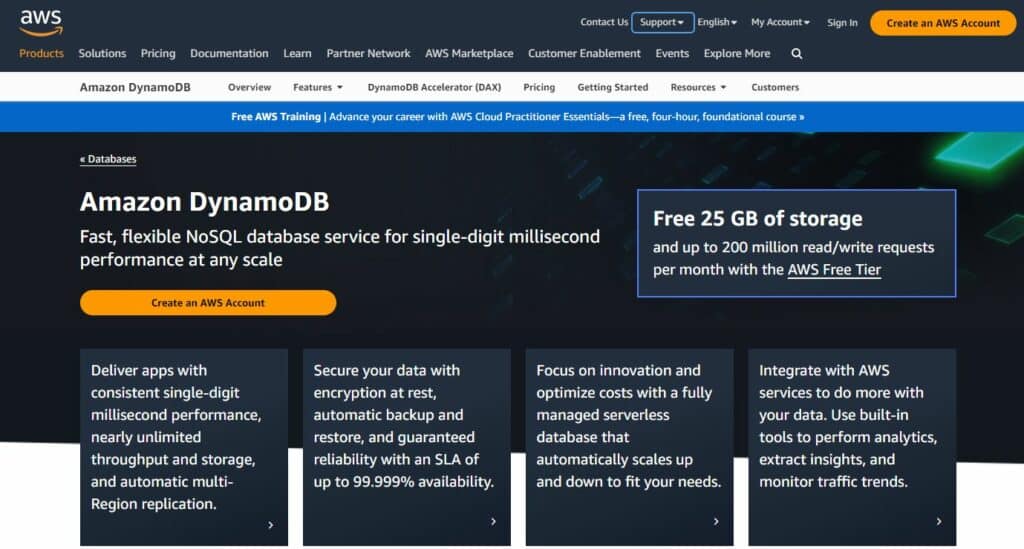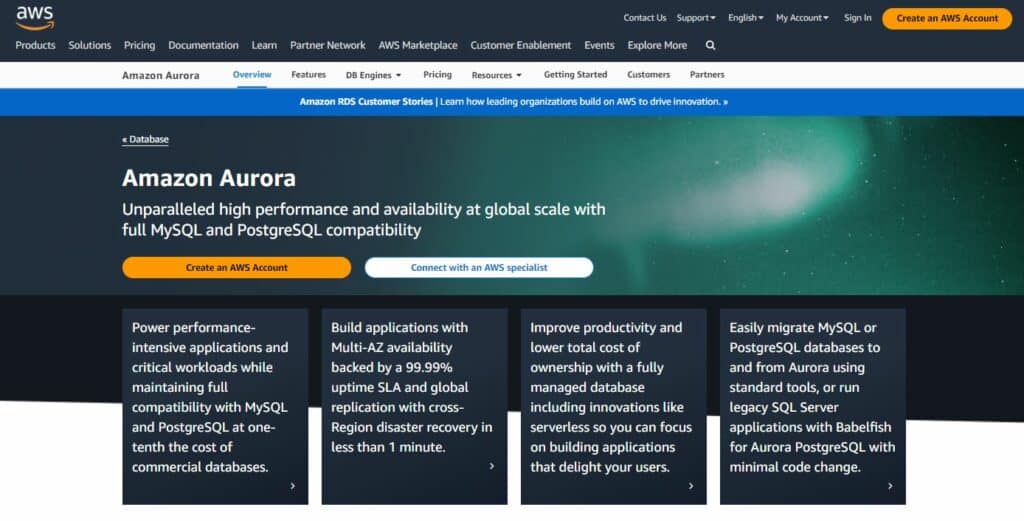
MMS • RSS
Databases are an important part of the Amazon Web Services (AWS) ecosystem because they help manage and organize huge amounts of data in a safe and efficient way. AWS has many different database services, each designed to meet the needs of different people who need to store and get data. DynamoDB is a NoSQL database service that is known for its high performance, seamless scalability, and flexible data models. This makes it a great choice for applications that need to access data quickly and with low latency.
On the other hand, Amazon Aurora, a relational database service, is praised for being able to work with both MySQL and PostgreSQL. It offers the speed and availability of commercial databases while being cheaper and easier to use than open-source databases. Amazon Aurora is a popular choice for applications that need to be available and perform well all the time. It is very durable, has strong security features, and works well.
DynamoDB vs Amazon Aurora Comparison Table
DynamoDB is a NoSQL database that is known for its low latency, ability to automatically scale, and suitability for serverless computing. Aurora, on the other hand, is a relational database that supports transactions, strong consistency, and complex queries. It needs to be scaled and deployed by hand.
| Feature | Amazon DynamoDB | Amazon Aurora |
|---|---|---|
| Database Type | NoSQL database | Relational database |
| Scalability | Automatically scales to handle any amount of traffic | Can be manually scaled, but requires more management |
| Data Model | Key-value and Document store | Table and row-based data model |
| Read/Write Performance | Low latency for read and write operations | High read performance, suitable for complex queries |
| ACID Compliance | Eventual consistency for reads (by default), strong consistency for writes | Fully ACID-compliant |
| Secondary Indexes | Global and Local Secondary Indexes are supported | Supports secondary indexes for enhanced query performance |
| Query Language | Querying is done using API calls or SQL-like expressions | SQL-based querying using standard MySQL or PostgreSQL interfaces |
| Use Case | Ideal for applications requiring scalable, high-performance, and low-latency data storage | Suitable for applications with complex querying needs and transactional workloads |
| Pricing Model | Pay-per-use model based on provisioned throughput and storage | Pay-per-use model based on compute and storage resources |
| Backup and Recovery | Continuous backups with point-in-time recovery | Supports automated backups and snapshots for data protection |
| Availability | High availability with built-in replication and multi-region support | Replication and failover support for high availability |
| Use with Serverless | Well integrated and suitable for serverless computing | Requires a server or instances for deployment |
| Visit Website | Visit Website |
DynamoDB vs Amazon Aurora: Data Model and Structure


There are two powerful database services that Amazon Web Services (AWS) offers. They are DynamoDB and Amazon Aurora. Their data models and structures are different, so they can be used for different kinds of tasks. The term “NoSQL” refers to a database that does not use a relational database schema. A key-value and document data model is used instead. Because of this, DynamoDB is very adaptable and scalable, as it can easily handle a lot of data with different formats.
On the other hand, Amazon Aurora is a relational database service that works with both MySQL and PostgreSQL. It has tables, columns, and rows, just like a normal relational database. Because of this, Amazon Aurora is a good choice for apps that need to do a lot of complicated queries and transactions.
| Feature | DynamoDB | Amazon Aurora |
|---|---|---|
| Data model | NoSQL (key-value and document) | Relational (tables, columns, and rows) |
| Primary key | Single attribute or composite attribute | Single column or composite column |
| Secondary indexes | Yes | Yes |
| Foreign keys | No | Yes |
| Scaling | Horizontal | Vertical |
The building blocks of DynamoDB tables are items, which are groups of attribute-value pairs. A primary key is what identifies an item. A primary key can be a single attribute or a group of attributes. DynamoDB also has secondary indexes that can be used to search for items based on secondary keys. DynamoDB tables can be scaled horizontally, which means that you can add more replicas to a table to make it bigger. That’s why DynamoDB is very scalable and can handle a lot of queries.
Tables in Amazon Aurora are made up of rows, which are groups of columns. Each column holds a different type of data, like an integer, a string, or a date. A primary key, which can be a single column or a group of columns, tells you which row it is. Foreign keys are another feature of Amazon Aurora that can be used to connect tables. You can increase the size of an Amazon Aurora table by adding more resources to the instance that it is running on. This is called “vertical scaling.” Because of this, Amazon Aurora is a good choice for apps that need to be fast and scalable.
DynamoDB vs Amazon Aurora: Performance and Scalability
There is very little latency and a lot of throughput with both DynamoDB and Aurora. DynamoDB, on the other hand, is thought to be faster than MySQL, especially for workloads that do a lot of reading. This is because DynamoDB is a NoSQL database, which means it doesn’t need SQL queries. Instead, DynamoDB stores data using a key-value and document model. This lets it get data quickly without having to read and run SQL queries.
Aurora, on the other hand, works with SQL queries and is a relational database. This means that Aurora might be a little slower than DynamoDB for workloads that need to read a lot, especially for queries that are complicated. However, Aurora is faster than DynamoDB for workloads that require a lot of writing. It can do this because Aurora can group writes together and process them faster.
| Feature | Amazon DynamoDB | Amazon Aurora |
|---|---|---|
| Database model | NoSQL | Relational |
| Performance | Very low latency, high throughput, especially for read-intensive workloads | Very low latency, high throughput, especially for write-intensive workloads |
| Scalability | Highly scalable horizontally to petabytes of data and millions of requests per second | Highly scalable horizontally to hundreds of terabytes of data and millions of transactions per second |
| Serverless | Yes | No |
DynamoDB and Aurora are both very scalable databases. It’s possible for DynamoDB to handle petabytes of data and millions of requests per second. This means that Aurora can handle hundreds of terabytes of data and millions of transactions per second. However, DynamoDB is generally thought to be the more scalable of the two. That’s because DynamoDB is a serverless database, which means you don’t have to set up or manage any servers. You never have to worry about running out of space because DynamoDB makes changes based on demand.
Aurora, on the other hand, is a provisioned database, which means you need to set aside enough space to handle your busiest times. This could be a problem for apps whose workload changes often. Amazon DynamoDB and Amazon Aurora are both great databases that work well and can grow as needed. There are, however, some important differences between the two that may make one a better choice for you.
DynamoDB vs Amazon Aurora: Data Management and Security Features


DynamoDB is a fully managed NoSQL database service that can handle loads of millions of records in just a few milliseconds. It’s a good choice for programs that need to deal with a lot of data and access it in unpredictable ways. DynamoDB has a number of features for managing data, such as
Automatic scaling: Because DynamoDB automatically scales up or down capacity based on demand, you don’t have to worry about setting up or managing capacity yourself.
Global tables: DynamoDB global tables give you a logical view of all of your data in all of your AWS regions. With low latency and high availability, this makes it easy to build global apps.
Streams: DynamoDB streams let you know when your data changes in real time, so you can make apps that respond to changes right away.
This is a fully managed relational database service from Amazon that combines the speed and scalability of MySQL and PostgreSQL with the security and compatibility of a commercial database. Applications that need the speed and ability to grow like a relational database but also want the adaptability and low cost of a cloud database should choose this one. Amazon Aurora has a number of features for managing data, such as
- Automatic backups and software patches: Amazon Aurora backs up your data and patches the database software for you, so you don’t have to do anything.
- Multi-AZ deployments: For high availability, Amazon Aurora deployments can be spread out across multiple Availability Zones (AZs).
- Read replicas: To increase the amount of data that can be read, Amazon Aurora read replicas can be used.
- Serverless mode: When you use Amazon Aurora Serverless mode, the capacity automatically scales up or down based on demand, so you don’t have to worry about setting up or managing capacity.
DynamoDB and Amazon Aurora both have a number of security features that can keep your data safe, such as
- Encryption: Both DynamoDB and Amazon Aurora encrypt your data while it’s being sent and while it’s being stored.
- Access control: Both DynamoDB and Amazon Aurora let you control who can see your data in very specific ways.
- Auditing: You can keep track of who is accessing your data and what they are doing with it with both DynamoDB and Amazon Aurora’s auditing features.
DynamoDB vs Amazon Aurora: Querying Capabilities and Indexing
The relational database schema is not used by DynamoDB because it is a NoSQL database. It uses a key-value store model instead, where each item has a primary key that makes it unique. DynamoDB also has secondary indexes that let you search for data based on other attributes.
DynamoDB queries are very quick, especially for simple queries. Complex queries, like joins and aggregations, can be harder to put together, though. Also, DynamoDB doesn’t work with some of the more advanced SQL features, like window functions and subqueries.
| Feature | DynamoDB | Amazon Aurora |
|---|---|---|
| Query language | PartiQL, DynamoDB API | SQL |
| Querying capabilities | Simple queries are very fast, complex queries can be challenging | Can handle complex queries and aggregations with ease |
| Supported SQL features | Basic SQL features | All SQL features supported |
| Indexing | Local secondary indexes only | Local and global secondary indexes supported |
| Performance | Very fast for simple queries | Generally slower than DynamoDB, but more flexible |
It works with both MySQL and PostgreSQL. Amazon Aurora is a relational database engine. To query your data, this means you can use all of the standard SQL tools. Like DynamoDB, Aurora can also use secondary indexes. Aurora queries are usually slower than DynamoDB queries, but they can be used in a lot more situations. Simple queries and collections are easy for Aurora to handle. It also works with all the more advanced SQL features that DynamoDB doesn’t.
When deciding between DynamoDB and Aurora, indexing is another important thing to think about. DynamoDB only works with local secondary indexes, which means that the data for the index is kept in the same partition as the data for the items. Large tables may have trouble running because of this. Aurora works with both global and local secondary indexes. It can help large tables run faster because global secondary indexes are kept in separate partitions from the item data. It can be more expensive and hard to use global secondary indexes, though.
DynamoDB vs Amazon Aurora: Integration with Other AWS Services
DynamoDB is a durable database that is fully managed, has multiple regions and masters, and comes with built-in security, backup and restore, and in-memory caching for internet-scale applications. It works with a lot of different AWS services, such as
- Amazon Lambda: The Amazon Lambda service lets you run Lambda functions from DynamoDB. These functions can then process data in DynamoDB or other AWS services.
- Amazon Kinesis: DynamoDB can be used to get data from Amazon Kinesis streams. This data can then be processed and analyzed in real time.
- Amazon Redshift: There is a service called Amazon Redshift that lets you store and analyze data. DynamoDB can be used to load data into Redshift.
- Amazon Athena: Athena is a serverless interactive query service that makes it easy to look at data in Amazon S3. DynamoDB can be used to query data using Athena.
- Amazon SageMaker: DynamoDB can be used to store data that is used to train and run machine learning models in Azure.
- The Amazon Aurora
Amazon Aurora is a relational database that works with both MySQL and PostgreSQL and is fully managed. It works with a lot of different AWS services, such as
- Amazon Relational Database Service (RDS): If you use Aurora with Amazon Relational Database Service (RDS), you can make a managed, scalable, and relational database service.
- Amazon Lambda: You can use Aurora to start Lambda functions, which can then be used to process data in Aurora or other AWS services.
- Amazon Kinesis: A tool called Aurora can take data from Kinesis streams and process and analyze it in real time.
- Amazon Redshift: Aurora can be used to put data into Redshift, which can then be used to store data and run analytics on it.
- Amazon Athena: Athena is a serverless interactive query service that makes it easy to look at data in Amazon S3. Aurora can be used to query data using Athena.
- Amazon SageMaker: Azure can be used to store data that is used to train and run machine learning models in Amazon SageMaker.
DynamoDB: Pros and Cons
Pros
- Automatic scalability for handling any workload.
- Low-latency performance for read and write operations.
- Well-suited for serverless computing environments.
Cons
- Limited querying capabilities compared to SQL-based databases.
Amazon Aurora: Pros and Cons
Pros
- Strong consistency and support for complex querying.
- ACID compliance for reliable transactions.
- Better suited for applications with complex data needs.
Cons
- Requires manual scaling, leading to more management overhead.
DynamoDB vs Amazon Aurora: which one should you consider?
The choice between Amazon Aurora and DynamoDB depends on the needs and use cases. A NoSQL database called DynamoDB is great for applications that need to be able to scale easily, be available all the time, and have low latency. This means it can handle real-time situations and heavy workloads.
Amazon Aurora, on the other hand, is a relational database that works like MySQL and PostgreSQL, but it also has the added benefits of being scalable, durable, and fast. This means it can handle both simple and complex queries. DynamoDB is better if your application needs to handle real-time needs and have flexible data models. On the other hand, Amazon Aurora is a strong option for structured data and complex querying needs.
FAQs
The main type of database in Amazon Aurora is a Relational DBMS. The main type of database in Amazon DynamoDB is a key-value store and document store. Amazon Auroras can be split up in a horizontal direction. The sharding partitioned method is used by Amazon DynamoDB.
Aurora Replicas use the same storage as the source instance. This saves money and keeps the replica nodes from having to do writes. This makes more processing power available for read requests and cuts the time it takes to make a copy, often to just a few milliseconds.